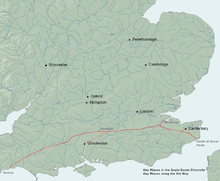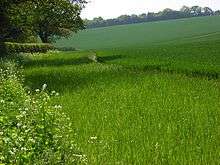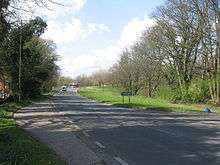Harrow Way

The Harrow Way (also spelled as Harroway) forms the western part of the Old Way, an ancient trackway in the south of England, dating from the Neolithic period, which is split into a western and eastern part.


The Old Way
The Eastern part and the Pilgrims' Way
The eastern part of the Old Way, most of which is misleadingly named[1] the Pilgrims' Way, which today runs on or parallel to the North Downs Way, can be traced from Rochester and alternative Channel ports on the Straits of Dover, a principal track also starting in the valley of the Great Stour from Canterbury, to lead along the North Downs or its southern slopes, through Maidstone and Guildford to Farnham, Surrey. With its natural season-round well-drained soil, slightly more humus-rich than the crest itself, forming the most travelled of often several terraced routes.[2]
The Pilgrims' Way continues from Farnham more south-west than west to Winchester. This route was later used in some pilgrimages and helped the growth of Winchester. Winchester, apart from being an ecclesiastical centre in its own right (the shrine of St Swithin), was an important regional focus and an aggregation point for travellers arriving through the seaports on the south coast.[3]
see Early British Christianity
Significant earlier usage of this section of the Pilgrims' Way is likely noting it does pass several British Iron Age (Celtic) barrows on hills to north and south, for instance, villages around Alresford such as Tichborne, continuing to the Celtic and Roman settlement of Winchester (Venta Belgarum) on the River Itchen north of Southampton. The Diocese of Winchester (seat of the Bishop of Winchester) was founded in 660 CE.[4]
The western part of the Old Way, the Harrow Way, can by contrast be traced from Farnham, Surrey west through Basingstoke and Andover to Salisbury Plain and Stonehenge, Wiltshire, through Dorset and on to Seaton on the Devon coast.[5][6]
The Harrow Way

The name may derive from herewag, a military road; har, ancient (as in hoary) way or heargway, the road to the shrine (perhaps Stonehenge).[7] It is sometimes described as the 'oldest road in Britain' and is possibly associated with ancient tin trading.[5]
The eastern end of the Harrow Way, where it becomes the Pilgrims' Way, is at Farnham, a second aggregation point for travellers joining from the south coast.[3] Gibson reports the section going eastward just north of Farnham ran through the area now Farnham Park and continued its course along the chalk outcrop, crossed the Bagshot Road where the Six Bells pub now stands and continued past Badshot Lea, Surrey where an important Neolithic Long Barrow burial mound (tumulus) was found. The Harrow Way then continues to the crest of the Hog's Back where the ancient trackway is known to have run.[8] There are several barrows along the Hog's Back.
In Dorset, the Harrow Way can be traced through the villages of Halstock and Corscombe, where it is known as Common Lane. At the Halstock end, a short length was realigned to form the access for a Roman villa (which was built on the site of a late Iron Age farmstead).[9]
References
- ↑ See article, this term is anachronistic
- ↑ Wright, Christopher John (1971). A Guide to the Pilgrims' Way. Constable and Co, London. ISBN 0-09-456240-7
- 1 2 Wright, Christopher John (1971): A Guide to the Pilgrims' Way. Constable and Co, London.
- ↑ according to Old Minster, Winchester
- 1 2 Daily Telegraph. 09 Oct 2008 Greywell and the Harroway. Christopher Somerville sets out on his 200th Walk of the Month
- ↑ Saxon Farnham by Elfrida Manning, Phillimore & Co, 1970
- ↑ Grinsell, Leslie (1958). The archaeology of Wessex. London: Methuen. p. 298. OCLC 400319.
- ↑ J.H. Gibson MD, Surrey Archaeological Society, Prehistoric Finds
- ↑ P.R. Lemmey, A History of Halstock, ISBN 0-9512063-0-3